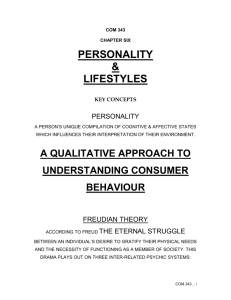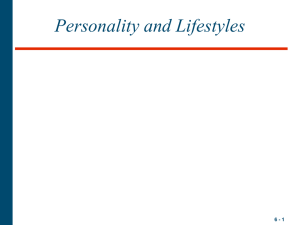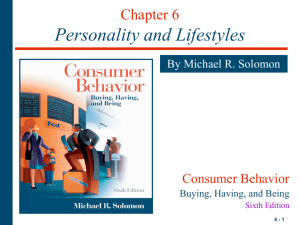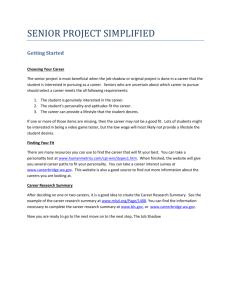Consumer Behavior: People in the Marketplace
advertisement
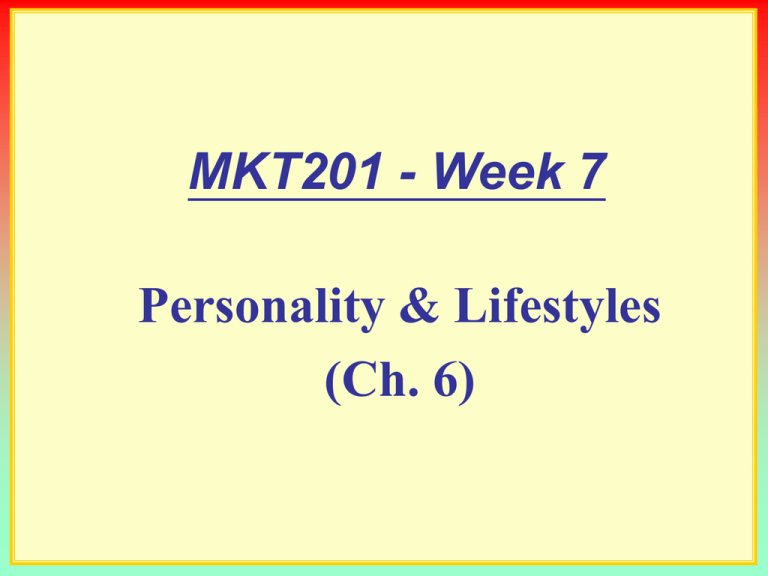
MKT201 - Week 7 Personality & Lifestyles (Ch. 6) Personality • Personality refers to a person’s unique psychological makeup and how it consistently influences the way a person responds to his or her environment. • Most now agree that both personality and situational factors play a role in determining people’s behavior. • Personality is usually involved, along with: – A person’s choices of leisure activities, political outlook, aesthetic tastes, and – Other individual factors to segment customers in terms of Lifestyles. Consumer Behavior on the Couch: Freudian Theory • Freudian Systems: – Id 原我 : Oriented toward immediate gratification • Pleasure principle: Behavior is guided by the primary desire to maximize pleasure and avoid pain • The id is selfish, illogical, and ignores consequences – Superego 超我 : A person’s conscience (moral & ethical) – Ego 自我 : The system that mediates between the id and the superego • Reality principle: The ego finds ways to gratify the id that will be acceptable to the outside world Consumer Behavior on the Couch: Freudian Theory • Freud, Sigmund 佛洛伊德 • 1856-1939 • Austrian physician and founder of psychoanalysis who theorized that the symptoms of hysterical patients represent forgotten and unresolved infantile psychosexual conflicts. His psychoanalytic theories, which initially met with hostility, profoundly influenced 20th-century thought. Consumer Behavior on the Couch: Freudian Theory Id Reality Principle Oriented Towards Immediate Gratification Pleasure Principle Ego Referee in the Fight Between Temptation and Virtue Superego Person’s Conscience Counterweight to id Conflict Between the Id and Superego • This ad focuses on the conflict between the desire for hedonic gratification (represented by the id) versus the need to engage in rational, task-oriented activities (represented by the superego). (e.g. id: desire deep sleep Vs Superego: better relax briefly) Consumer Behavior on the Couch: Freudian Theory • Freudian Applications in Marketing – related to sexuality of products (e.g. sports car –> sex) • Others focus on male-oriented symbolism (Phallic symbols) • Phallic symbols: Male-oriented symbolism – Sometimes a Cigar is Just a Cigar – Use of objects resembling sex organs – (e.g. cigars, trees, swords for male sex organs; tunnels for female sex organs) Do you believe that these so-called “Phallic Symbols” truly exist, or is it all just a coincidence? Take a look at Camel cigarettes famous mascot (bringing luck), Joe Camel, and discuss. http://www.joechemo.org Motivational Research • Motivational Research: – Attempts to use Freudian ideas to understand the deeper meanings of products and advertisements in the 1950s – Depth Interviews: Technique that probes deeply into a few consumers’ purchase motivations • Latent motives: Underlying motives • Appeal of Motivational Research – Less expensive than quantitative survey research – Uncovers deep seated needs which can be targeted with advertising – Findings seem intuitively plausible after the fact Motives for Consumption Neo-Freudian Theories • Karen Horney: – Described people as moving toward others (compliant), away from others (detached), or against others (aggressive). • Carl Jung: – Disciple of Freud but did not accept Freud’s emphasis on sexual aspects of personality – Analytical psychology: Jung’s own method of psychotherapy – Collective unconscious: A storehouse of memories inherited from our ancestral past – Believed people are shaped by cumulative experiences of past generations – Archetypes: Universally shared ideas and behavior patterns created by shared memories (e.g. afraid of dark) Trait Theory • Trait Theory: – An approach to personality that focuses on the quantitative measurement of personality traits • Personality Traits: – Identifiable characteristics that define a person. – Extroversion: Trait of being socially outgoing • Extrovert: A person that possesses the trait of extroversion – Introversion: Trait of being quiet and reserved • Introvert: A person that possesses the trait of introversion Traits Specific to Consumer Behavior • Innovativeness: – The degree to which a person likes to try new things • Materialism: – Amount of emphasis placed on acquiring and owning products • Self-consciousness: – The degree to which a person deliberately monitors and controls the image of the self that is projected to others • Need for cognition: – The degree to which a person likes to think about things (i.e., expend the necessary effort to process brand information) • Frugality: – Deny short-term purchasing whims/fancy and resourcefully use what one already owns Are You an Innie or an Outie? • David Reisman: – Sociologist who introduced the terms inner-directed (concern of oneself) and outer-directed (concern of others) – Individualism Vs Collectivism • Power of Conformity (in Ch. 11 - Group Influence) – The impact of shaping one’s behavior to meet the expectations of a group • Need for Uniqueness – Degree to which a person is motivated to conform to the preferences of others versus standing apart from the crowd Discussion Question • This classic ad starts off with the line: “The Datsun 240-Z is not exactly what you would call a common site.” • What consumer personality trait is this ad appealing to? Idiocentrism or Allocentrism • Idiocentrics: – • Allocentrics: – • Individuals who have an individualist orientation Individuals who have a group orientation Differences between idiocentrics and allocentrics: 1. Contentment: Idiocentrics tend to be more content with life and their financial situation 2. Health Consciousness: Allocentrics are more likely to avoid unhealthy foods 3. Food preparation: Allocentrics spend more time preparing food 4. Travel and Entertainment: Idiocentrics are more interested in traveling. Allocentrics are more likely to work on crafts. Problems with Trait Theory in CB • Explanations for the inability of traits to predict consumer behaviors in research: – Scales which are not valid or reliable. – Scales misapplied to the general population – Tests not administered under the proper conditions – Ad hoc changes to the measures dilute the validity of the measures – Generalized trait measures used to make predictions about specific behaviors – Shotgun approach using a number of scales (following up anything that happens to look interesting) Brand Personality • Brand personality: – The set of traits people attribute to a product as if it were a person • Brand equity: – The extent to which a consumer holds strong, favorable, and unique associations with a brand in memory • Advertisers are keenly interested in how people think about brands. Brands and Trait Inferences Animism • Animism: – The practice found in many cultures whereby inanimate objects are given qualities that make them somehow alive • Two types of animism: – Level 1: People believe the object is possessed by the soul of the being (e.g. celebrity spokespersons) – Level 2: Objects are anthropomorphized, or given human characteristics. (e.g. Charlie the Tuna, Keebler Elves, or the Michelin Man) Animism – Level 2: Objects are anthropomorphized, or given human characteristics. (e.g. Charlie the Tuna, Keebler Elves, or the Michelin Man) Brand Personality Brand Equity Extent That a Consumer Holds Strong, Favorable, and Unique Associations about a Brand in Memory. Brand Personality Assigning Personality Qualities to Inanimate/dead Products That Makes the Product Stand Out From the Competition. Animism Inanimate Objects are Given Qualities That Make Them Somehow Alive. Level 2: Objects are Level 1: Object is Believed to Possessed by the Soul of a Being. Anthropomorphized - Given Human Characteristics. (loved/alive/deceased (Felix the Cat) spokesperson in advertising) Lifestyle: Who We Are, What We Do • Lifestyle: – Refers to a pattern of consumption reflecting a person’s choices of how he or she spends time and money • Lifestyle Marketing Perspective: – Recognizes that people sort themselves into groups on the basis of things they like to do, how they like to spend their leisure time, and how they choose to spend their disposable income • Lifestyles as Group Identities: – Self-definitions of group members Integrating Products into Consumer Lifestyles • This ad illustrates the way that products like cars are tightly integrated into consumers’ lifestyles, along with leisure activities, travel, music, and so on. Products are the Building Blocks of Lifestyles • Choosing products: – We often choose products because of their association with a certain lifestyle. • Goal of Lifestyle Marketing: – To allow consumers to pursue their chosen ways to enjoy life and express their social identities. • Adopting Lifestyle Marketing: – Implies that we must look at patterns of behavior to understand consumers Linking Products to Lifestyles social setting/situation Figure 6.2 Product-Lifestyle Linkages • Co-branding strategies: – Strategies that recognize that even unattractive products are more attractive when evaluated with other, liked products • • • • Porsche – Fairmont Hotel Unilever (consumer foods) – Dove (skin/hair care) Nike – Polaroid Roxy (swimsuits, surfboards) – Toyota • Product complementarity: – Occurs when symbolic meanings of products are related to each other – Consumption constellations: • Sets of complementary products used to define, communicate and perform social roles (e.g. Yuppie: rolex, BMW, Gucci, etc.) Yuppie: A young city or suburban resident with a well-paid professional job and an affluent, materialistic lifestyle. The Sims (http://thesims.ea.com) Psychographics S4 • Psychographics: – Use of psychological, sociological, and anthropological factors for market segmentation • The Roots of Psychographics: – Developed in the 1960’s and ’70’s to address the shortcomings of motivational research and quantitative survey research • Forms of Psychographic Studies: – Lifestyle profile (users Vs nonusers) – Product-specific profile (profiles consumers on product-relevant dimensions) – General lifestyle segmentation profile (based on similarities of the overall preference) – Product-specific segmentation (consumers’ responses to one single product category) Conducting A Psychographic Analysis Forms of a Psychographic Study: Lifestyle Profile Product-Specific Profile Study That Uses Personality Traits as Descriptors General Lifestyle Segmentation Product-Specific Segmentation Definition of Psychographics: Involves the “.. use of psychological, sociological, and anthropological factors…” to determine how the market is segmented by the propensity of groups within the market - and their reasons - to make a particular decision about a product, person, ideology, or otherwise hold an attitude or use a medium. Adidas Psychographic Segments (see p. 214-215) S5 • “Gearhead” – older runner looking for high performance • • • • • • • shoes “Core Letterman” – white, suburban high school athlete “Contemporary Letterman” – high school athlete, boosting attractiveness “Aficionado” - a devotee or a fan; urban kid looking for brand-new, US$100-plus basketball shoe “Popgirl” – teeny-bopper who hangs out at the mall and wear Skechers “Value Addict” – middle-aged, fairly well-off person “A-Diva” – Sex and the City goes to the gym. “Fastidious Eclectus” – cutting-edge person who wants hip/fashionable, distinctive products AIOs • AIOs: – Psychographic research attempts to group consumers according to activities, interests, and opinions (AIOs) • Table 6.3 lists the commonly used AIO dimensions. AIOs and Lifestyle Dimensions AIOs • 80/20 Rule: – Only 20 percent of a product’s users account for 80 percent of the volume of product sold – Researchers attempt to identify the heavy users of a product – Heavy users can then be subdivided in terms of the benefits they derive from the product or service. AIOs and Psychographics Activities Interests Opinions Demographics - Describes Who Buys Psychographic Profiles - Tells Why Consumers Buy 80/20 Rule (20% of users account for 80% of product sold) Uses of Psychographic Segmentation Market Social and Political Issues Develop Overall Strategy Communicate Product Attributes Define the Target Market Create a New View of the Market Position the Product Discussion Question • The pictures at the right depict two very different “ideal” vacations. • How can psychographic segmentation help identify target markets for each type of vacation? Psychographic Segmentation Typologies • Segmentation Typologies: – Developed by companies and advertising agencies to identify groups of consumers with common lifestyles – Similarities in segmentation typologies: • • • • Respondents answer a battery of questions Researchers classify them into “clusters” of lifestyles Each cluster is given a descriptive name A profile of the “typical” member is provided to the client • Proprietary Systems: – Information is developed and owned by the company and the company will not release the info to outsiders VALS 2 (a well known segmentation system) – Uses a Battery of 39 Items (35 Psychological and 4 Demographic) to Divide U.S. Adults Into 8 Groups, Each With Distinctive Characteristics – 3 Self-Orientations (original model) 1. Principle orientation: not concerned with the views of others 2. Status orientation: making decisions based on the perceived opinions of peers 3. Action/Self orientation: buy products to have an impact on the world around them VALS 2 Abundant Resources Segmentation System (original model) Actualizers Principle Oriented Status Oriented Action Oriented Fulfilleds Achievers Experiencers Believers Strivers Makers Strugglers Minimal Resources VALS 2 Segmentation System Textbook: p.221 (modified new model) http://www.sricbi.com/VALS/types.s html Mistakes in p. 220 Actualizers should be “Innovators” Fulfilleds should be “Thinkers” Figure 6.3 Lifestyle Classification of Consumers • Global MOSAIC: – – – • Developed by a British Firm called Experian Analyzes consumers in 19 countries Identified 14 common lifestyles RISC (Research Institute on Social Change): – Identifies 10 segments based on three axes: 1. Exploration/Stability 2. Social/Individual 3. Global/Local Discussion • Extreme sports. Day trading. Blogging. Vegetarianism. Can you predict what will be “hot” in the near future? – Identify a lifestyle trend that is just surfacing in your universe. – Describe this trend in detail, and justify your prediction. – What specific styles and/or products are part of this trend? The Article • Secrets of The Male Shopper (Business Week, Sept 4, 2006) Male Shoppers: 5 cohorts/clusters/archetypes 1. 2. 3. 4. 5. Metrosexual Maturiteen Modern Man The Dad Retrosexual The Male ShoppersArticle 1. Metrosexual – affluent urban sophisticate aged 20-50 absolutely shops on, looking for quality and beauty. (targeted by P&G, Polo Ralph Lauren) 2. Maturiteen – more savvy (knowledgeable, practical), responsible, mature, and pragmatic. (targeted by Adidas, Sony) 3. Modern Man – neither retro or metro, something in the middle, aged between 20s-30s. likes American football, not really loves shopping. (targeted by Philips) 4. The Dad – married with children, peak in earning years. (targeted by Dyson vacuum cleaner, Patek Philippe) 5. Retrosexual – traditionalist, rejects feminism, with traditional male behaviour, nostalgic. (targeted by Burger King, P&G’s Old Spice brand)
